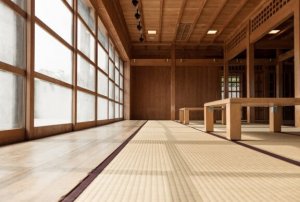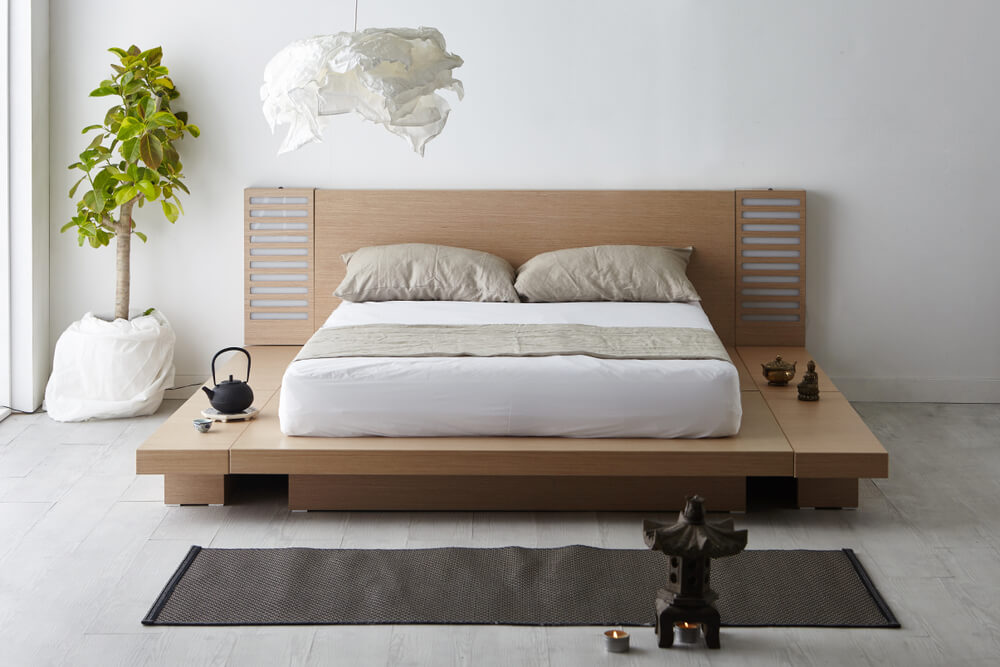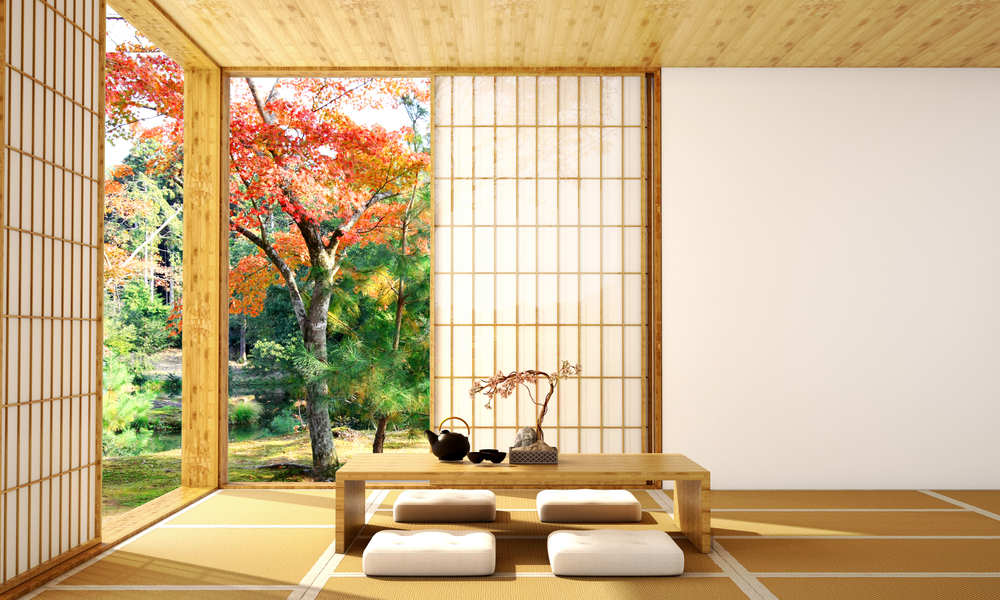Oriental Style Decor: A Question of Balance

Today, we want to give you a quick overview of one of the most spiritual styles in interior decorating. The oriental style is inspired by the principles of zen, and heavily influenced by Chinese and Japanese cultures. This decorative style is both exotic and peaceful. Its main aim is to create a sense of order, with spacious rooms and a great layout. It is a style that simply oozes magic, harmony, and tranquillity.
If you’re looking for a style for your home, and you love simple, harmonious, peaceful and balanced decor, this is perfect for you. In this article, you’ll find everything you need to know to go about creating the look.
As with every style, you’ll need to tailor it to your own personal taste. There are a few basic rules you’ll need to keep in mind if you want to get the oriental look. These rules cover everything from the wall colors and the type of furniture, to the layout of your rooms, and the various decorative elements.
The oriental style: colors

One of the most important things to keep in mind when it comes to creating unmistakably oriental decor is the color pallet. One color should feature more heavily than the rest, and should mainly be used for the walls.
The only rule when it comes to oriental style colors is that they should be strong, intense tones. This means you have a wide range of colors to choose from. You can never go wrong with purple or turquoise, which are classic colors of the oriental style.
But it’s not just a question of personal preference. In the oriental style, colors take on a special significance. Each color represents one of the five natural elements, which are essential for creating that all important sense of balance.
Warm colors, such as yellow, represent light. Reds symbolize fire and the flame of good luck. Oranges represent excitement and are great for living rooms, or even dining rooms.
Cool colors also carry meaning. White symbolizes order, peace, and tranquillity. Blues symbolize water and the sky and are used to bring balance and to give rooms a greater sense of calm and freshness. Greens represent life and balance.
Whites are best for work areas, while blues are great for bathrooms. In the dining room, people usually use oranges and reddish tones. You can also use blues for bedrooms, as well as greens.
Furniture

Oriental style furniture is essential. This style favors low furniture. There’s no room for floor to ceiling boiseries; at most you’ll find furniture half the height of the walls. The tables are also low, with far shorter legs than those you normally find. This theme is repeated in bedrooms, where beds are replaced by futons.
You should choose simple lines that are in harmony with the purity of your color pallet. There should be very little furniture, but with a high visual impact. This style makes use of elm, teak or tamarind wood furniture, and favors strong colors such as reds, oranges, blues and black.
Layout and lighting

The oriental style is characterized by wide open spaces. Common areas often have direct access to outdoor areas, while bedrooms are afforded maximum privacy. The flooring takes on a special significance, with oriental rugs featuring heavily. They become decorative elements in their own right and are used to mark the transition from one space to another.
Lighting is very important in the oriental style. Warm, indirect lighting is used to create a more intimate, sensual and peaceful environment. Candles are a must-have if you want to decorate your home in this style.
According to the principles of Feng Shui, light is a positive yang element and is an effective way to create balance and symmetry.
Decorative elements

Decorative elements are especially important with this style. In the case of oriental decor, fewer, larger items are better. Oriental style paintings, large sculptures, flowers, trays, vases or cushions in tones which match the rest of your decor.
Oriental decor favors natural elements. Water, stones, plants, incense, and candles are essential. In fact, you could get away with nothing more than a vase filled with stones and water.
A few, well-chosen decorations are all you need. These spaces are places of quiet introversion. The simplicity of the forms and the contrast of colors make every room a work of art.
Today, we want to give you a quick overview of one of the most spiritual styles in interior decorating. The oriental style is inspired by the principles of zen, and heavily influenced by Chinese and Japanese cultures. This decorative style is both exotic and peaceful. Its main aim is to create a sense of order, with spacious rooms and a great layout. It is a style that simply oozes magic, harmony, and tranquillity.
If you’re looking for a style for your home, and you love simple, harmonious, peaceful and balanced decor, this is perfect for you. In this article, you’ll find everything you need to know to go about creating the look.
As with every style, you’ll need to tailor it to your own personal taste. There are a few basic rules you’ll need to keep in mind if you want to get the oriental look. These rules cover everything from the wall colors and the type of furniture, to the layout of your rooms, and the various decorative elements.
The oriental style: colors

One of the most important things to keep in mind when it comes to creating unmistakably oriental decor is the color pallet. One color should feature more heavily than the rest, and should mainly be used for the walls.
The only rule when it comes to oriental style colors is that they should be strong, intense tones. This means you have a wide range of colors to choose from. You can never go wrong with purple or turquoise, which are classic colors of the oriental style.
But it’s not just a question of personal preference. In the oriental style, colors take on a special significance. Each color represents one of the five natural elements, which are essential for creating that all important sense of balance.
Warm colors, such as yellow, represent light. Reds symbolize fire and the flame of good luck. Oranges represent excitement and are great for living rooms, or even dining rooms.
Cool colors also carry meaning. White symbolizes order, peace, and tranquillity. Blues symbolize water and the sky and are used to bring balance and to give rooms a greater sense of calm and freshness. Greens represent life and balance.
Whites are best for work areas, while blues are great for bathrooms. In the dining room, people usually use oranges and reddish tones. You can also use blues for bedrooms, as well as greens.
Furniture

Oriental style furniture is essential. This style favors low furniture. There’s no room for floor to ceiling boiseries; at most you’ll find furniture half the height of the walls. The tables are also low, with far shorter legs than those you normally find. This theme is repeated in bedrooms, where beds are replaced by futons.
You should choose simple lines that are in harmony with the purity of your color pallet. There should be very little furniture, but with a high visual impact. This style makes use of elm, teak or tamarind wood furniture, and favors strong colors such as reds, oranges, blues and black.
Layout and lighting

The oriental style is characterized by wide open spaces. Common areas often have direct access to outdoor areas, while bedrooms are afforded maximum privacy. The flooring takes on a special significance, with oriental rugs featuring heavily. They become decorative elements in their own right and are used to mark the transition from one space to another.
Lighting is very important in the oriental style. Warm, indirect lighting is used to create a more intimate, sensual and peaceful environment. Candles are a must-have if you want to decorate your home in this style.
According to the principles of Feng Shui, light is a positive yang element and is an effective way to create balance and symmetry.
Decorative elements

Decorative elements are especially important with this style. In the case of oriental decor, fewer, larger items are better. Oriental style paintings, large sculptures, flowers, trays, vases or cushions in tones which match the rest of your decor.
Oriental decor favors natural elements. Water, stones, plants, incense, and candles are essential. In fact, you could get away with nothing more than a vase filled with stones and water.
A few, well-chosen decorations are all you need. These spaces are places of quiet introversion. The simplicity of the forms and the contrast of colors make every room a work of art.







